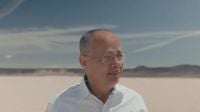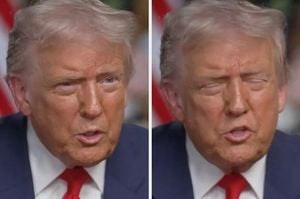On a brisk October morning in Washington, D.C., more than 300 scientists, engineers, and advocates gathered on Capitol Hill, united by a single, urgent mission: to defend the future of American science. Their rallying cry was sparked by the Trump administration’s proposal to slash NASA’s science budget by a staggering 47%. The move, described by Bill Nye—the beloved “Science Guy” and CEO of the Planetary Society—as an “extinction-level event for space exploration,” has sent shockwaves through the scientific community and beyond.
“If we cut NASA budget in half, science budget in half, that’s pretty much ending it, it’s pretty much done,” Nye warned during an interview with CNN’s Kaitlan Collins. “All these technicians, scientists, engineers have to get other jobs… You just can’t restart these things.” For Nye and his colleagues, the consequences are clear: the United States risks losing its edge in space exploration and scientific innovation, with ripple effects that could be felt by the public sooner than many realize.
As Nye pointed out, the world is not standing still. The China National Space Administration, for example, is charging ahead with plans to land Taikonauts on the Moon, likely by 2030. “For the older viewers it’s going to be another Sputnik moment,” Nye cautioned, referencing the shock Americans felt when the Soviet Union launched the first artificial satellite in 1957. “Where the United States’ eyebrows go up, ‘oh my goodness, the other side’s got some amazing space capability.’”
But the debate over science funding isn’t confined to NASA or Capitol Hill. Across the country, the stakes are just as high. This week, the University of California celebrated an extraordinary achievement: three Nobel Prizes in three days. At UC Berkeley, physics professor John Clark was still reeling from the news of his Nobel win for groundbreaking work in quantum tunneling, which is paving the way for a new class of supercomputers. “I wasn’t quite sure at the beginning whether or not this was a junk call,” Clark admitted, recalling his disbelief when he received the call from Sweden. “But it soon became clear that it was real. And I was just sitting there feeling completely stunned. It never occurred to me in my entire life that anything like this would happen.”
The very next day, Cal Professor Omar Yaghi won the Nobel Prize in Chemistry for his team’s work creating molecular structures that enable gases to flow through them. This breakthrough, Yaghi explained, could allow water to be harvested from desert air and even help remove toxic contaminants and carbon dioxide from the environment. “It was absolutely thrilling,” he said. “It’s — You cannot prepare for a moment like that. So, I was just surprised and delighted by the news.”
Yet, even amid these celebrations, both Clark and Yaghi voiced grave concerns about the future of U.S. science. Federal funding cuts, particularly at public universities, threaten to isolate the United States from the global scientific community. “This is an immensely serious problem,” Clark emphasized in an interview reported by KPIX. “I certainly know personally people who have lost most of their funding. And this will cripple much of the United States’ science research unless they reverse this procedure. If this continues, assuming that the present administration finally comes to an end, it may take a decade to get back to where we were, say, half a year ago.”
Yaghi was equally blunt: “Without funding, you can’t do science. Science costs money and it’s an investment into our future. We do have to compete with other countries, who also compete for our talent. So, we need to make sure that we fund science to a level that allows us to excel and to compete with others. Our science is the jewel in the crown of our country. So, we cannot allow that to slip.”
These warnings echo far beyond the halls of academia. In Boston, long considered the world’s leading hub for life sciences, the threat of federal cutbacks looms large. For more than a decade, Boston and Cambridge have boasted more lab space than anywhere else, with billions in venture capital and federal grants fueling a thriving ecosystem of startups and research institutions. Over the past 25 years, Boston-area institutions have drawn over $45 billion in funding from the National Institutes of Health, while Massachusetts has invested $2.6 billion in its life sciences sector since 2008.
Yet, as reported by The Boston Globe, the Trump administration’s policies now threaten two key pillars of Boston’s success: federal research grants and visas for international students and workers. Other cities—Toronto, Houston, Shenzhen, and Cambridge in the UK—are seizing the moment, investing heavily to attract talent and build their own life sciences hubs. Travis McCready, a former Massachusetts Life Sciences Center chief, observed, “There is only one Boston, and there can’t be another.” But he also warned, “The rest of the global community has caught up. They have wind in their sails, and they’ve created bespoke environments that are very unique and that are formidable in their own right.”
Indeed, the competition is fierce. Shenzhen now accounts for about 30% of all global life science licensing deals, while Cambridge, UK, is leveraging its storied university and a tenfold increase in venture capital to become Europe’s life sciences capital. Even Houston is making moves, with pharmaceutical giant Eli Lilly & Co. announcing a $6.5 billion manufacturing facility in the city. “It takes a long time to get to number one, but that’s always been our objective,” said Steve Kean, chief executive of the Greater Houston Partnership.
Recognizing the threat, Massachusetts Governor Maura Healey has proposed a $400 million package to support nonprofit research institutions and universities, aiming to offset lost federal grants. Harvard economist Amitabh Chandra cautioned that if the U.S. pulls back, foreign clusters—from China’s Academy of Sciences to Germany’s Max Planck Society—could capture slices of the American biotech business. “If we start to make things really bad for science and scientists, then the industry will shrink, and it’ll shrink throughout the United States,” Chandra warned.
For those on the front lines, the message is clear: American science stands at a crossroads. Bill Nye, ever the advocate, invoked the U.S. Constitution itself, quoting Article I, Section 8, Clause 8: “Congress is to promote the progress of science and useful arts.” For him, and for many others, the question is not simply about budgets or bureaucratic battles—it’s about the nation’s future. “If we stop looking up and out, what does that say about us?” Nye asked. “It’s not good… It’s certainly not consistent with how the United States has gotten this far.”
As the world races forward, the United States faces a pivotal choice: invest in the progress of science, or risk ceding its place at the forefront of discovery. The next chapter, it seems, will be written not just in laboratories and universities, but in the decisions made in Washington and beyond.





